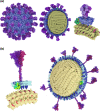Visualising Viruses
- PMID: 35082014
- PMCID: PMC8895616
- DOI: 10.1099/jgv.0.001730
Visualising Viruses
Abstract
Viruses pose a challenge to our imaginations. They exert a highly visible influence on the world in which we live, but operate at scales we cannot directly perceive and without a clear separation between their own biology and that of their hosts. Communication about viruses is therefore typically grounded in mental images of virus particles. Virus particles, as the infectious stage of the viral replication cycle, can be used to explain many directly observable properties of transmission, infection and immunity. In addition, their often striking beauty can stimulate further interest in virology. The structures of some virus particles have been determined experimentally in great detail, but for many important viruses a detailed description of the virus particle is lacking. This can be because they are challenging to describe with a single experimental method, or simply because of a lack of data. In these cases, methods from medical illustration can be applied to produce detailed visualisations of virus particles which integrate information from multiple sources. Here, we demonstrate how this approach was used to visualise the highly variable virus particles of influenza A viruses and, in the early months of the COVID-19 pandemic, the virus particles of the then newly characterised and poorly described SARS-CoV-2. We show how constructing integrative illustrations of virus particles can challenge our thinking about the biology of viruses, as well as providing tools for science communication, and we provide a set of science communication resources to help visualise two viruses whose effects are extremely apparent to all of us.
Keywords: SARS-CoV-2; influenza virus; visualisation.
Conflict of interest statement
The authors declare that there are no conflicts of interest.
Figures



References
Publication types
MeSH terms
Grants and funding
LinkOut - more resources
Full Text Sources
Medical
Miscellaneous

